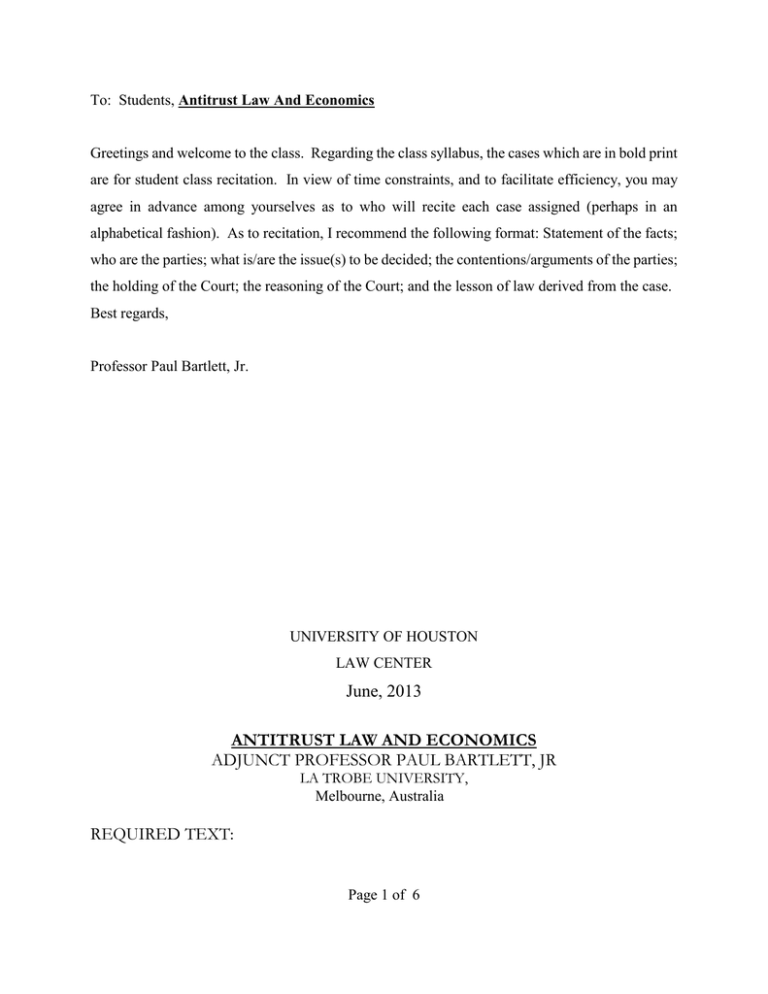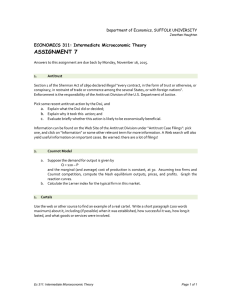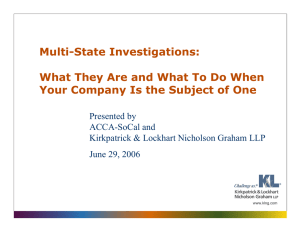Antitrust Law And Economics
advertisement

To: Students, Antitrust Law And Economics Greetings and welcome to the class. Regarding the class syllabus, the cases which are in bold print are for student class recitation. In view of time constraints, and to facilitate efficiency, you may agree in advance among yourselves as to who will recite each case assigned (perhaps in an alphabetical fashion). As to recitation, I recommend the following format: Statement of the facts; who are the parties; what is/are the issue(s) to be decided; the contentions/arguments of the parties; the holding of the Court; the reasoning of the Court; and the lesson of law derived from the case. Best regards, Professor Paul Bartlett, Jr. UNIVERSITY OF HOUSTON LAW CENTER June, 2013 ANTITRUST LAW AND ECONOMICS ADJUNCT PROFESSOR PAUL BARTLETT, JR LA TROBE UNIVERSITY, Melbourne, Australia REQUIRED TEXT: Page 1 of 6 Pitofsky, Goldschmid and Wood, Trade Regulation, 6th edition, 2010, with the 2011 Supplement (University Casebook Series, Foundation Press) Assigned Readings from Pitofsky et. al.: Chapter 1. (Lecture) The Objectives and Origins of Antitrust Law (pp. 1-53) Section 1. The Goals of Antitrust Policy 1. The Role of Competition and Alternatives to Competitive Markets 2. The Sherman Act and Comparative Legislation 2. The Historical Sources of Antitrust, Legislative History, and Early Developments 1. The Early Law on Monopoly and Contracts in Restraint of Trade 2. The Sherman Act - Some Legislative History 3. Early Development of Legal Doctrine Chapter II. (Lecture) Institutional Framework of Antitrust Policy (pp. 54-111) 1. 2. The Three Level Antitrust Enforcement Pattern 1. Sources of Antitrust Litigation 2. Special Issues Related to Enforcement by the Federal Agencies 3. Special Issue Related to Private Enforcement Reiter v. Sonotone Blue Shield v. McCready Hawaii v. Standard Oil Associated General Contractors v. California State Council Illinois Brick v. Illinois California v. Arc America 4. Special Issues Related to the “Big Case” The Limits of Antitrust 1. Government Ownership of the Means of Production 2. Regulated Industries 3. Interstate and Foreign Commerce 4. Additional Exemptions, Exclusions, and other Aspects of Economic Control Page 2 of 6 Chapter III Market Structure and a First Look at the Problem of Monopoly Power (pp. 112-176) 1. Monopolization and the Problem of Market Definition U.S. v. Alcoa U.S. v. Du Pont (Cellophane) U.S. v. Grinnell Note on Market Power and Consumer Loss (Lecture) Chapter IV Competitor Collaboration on Price Fixing and Division of Markets (pp. 177-246; 271-306) 1. 2. 3. 4. Conspiracy in Theory and Action Development of the “Per Se” Rule on Price Fixing U.S. v. Addyston Pipe & Steel Co. Chicago Board of Trade v. U.S. Appalachian Coals, Inc. v. U.S. U.S. v. Socony-Vacuum Oil Co., Inc. Characterization Questions and Other Issues Broadcast Music Inc, v. Columbia Broadcasting Systems, Inc. NCAA v. Board of Regents of University of Oklahoma Texaco Inc. v. Dagher Division of Territories and Some Other Horizontal Restraints Timken, General Motors, and Sealy (Lecture) U.S. v. Topco Associates, Inc. Palmer v. Barbri Chapter V Group Refusals to Deal and Joint Ventures (pp. 307-385) 1. Refusals to Deal F.O.G.A. v. FTC Klor’s Inc. v. Broadway-Hale Rambus v. FTC Northwest Wholesale Stationers v. Pacific Stationary Page 3 of 6 2. 3. FTC v. Superior Court Trial Lawyers Association Joint Ventures Revisited: Issues of Membership and Access Associated Press v. U.S. Efforts to Influence Government Action (Lecture) Columbia v. Onmi Outdoor Advertising (Lecture) Chapter VI Market Concentration, Conspiracy and the Antitrust Laws (pp. 469-506; 588-604) 1. 2. 3. Note on Oligopoly (469) Inference of Agreement as a Legal Building Block(471) Theatre Enterprises v. Paramount Film (479) Toys “R” Us, Inc. v. FTC (484) Todd v. Exxon Corporation (525) In re High Fructose Corn Syrup Antitrust Litigation (558) U.S. v. Container Corp. (p. 588) U.S. v. Gypsum (Lecture) Intra-Enterprise Conspiracy (p. 613) Copperweld v. Independence Tube Corp. (Lecture) American Needle v. NFL (Supplement, p. 1) Chapter VII Vertical Restraints on Competition (pp. 606-719)) 1. 2. The Economics of Vertical Restraints The Interplay of Common Law and Antitrust Laws 1. Vertical Price Fixing Dr. Miles v. John D. Park & Sons Co. (Lecture) State Oil v. Khan Leegin v. PSKS Note on Resale Price Maintenance and the Fair Trade Laws 2. Customer and Territorial Restraints Continental T.V., Inc. v. GTE Sylvania 3. Vertical Restraints and Refusal to Deal U.S. v. Colgate Co. U.S. v. Parke, Davis & Co.(Lecture) Page 4 of 6 Business Electronics Corp. v. Sharp Electronics Corp. Chapter VIII Additional Limitations on a Single Firm Exercising Market Power (pp. 721-919) 1. Monopoly Conduct Revisited Aspen Skiing Co. v. Aspen Highlands Verizon Communications v. Law Offices of Curtis V. Trinko United States v. Microsoft (767) 2. Attempt to Monopolize (Lecture) Lorain Journal v. United States Spectrum Sports v. McQuillan 3. Predatory Price Cutting (Lecture) Brooke Group v. Brown & Williamson Tobacco United States v. AMR Corp., American Airlines, Inc. Weyerhaeuser Co. v. Ross-Simmons Hardwood Lumber 4. Tying Arrangements Clayton Act, Section 3 International Salt Co. v. United States Jefferson Parish Hospital v. Hyde Eastman Kodak v. Image Technical Services (Lecture) Chapter IX Mergers (pp. 965-1168) 1. Background on Early Merger Law and the Amendment of Section 7 of the Clayton Act in 1950 Clayton Act, Section 7 2. Proscribed Effect in Horizontal Mergers U.S. v. Philadelphia National Bank U.S. v. Alcoa; U.S. v. Pabst Brewing; U.S. v. Von’s Grocery Hospital Corporation of America v. FTC Page 5 of 6 3. 4. U.S. Department of Justice and FTC Joint Horizontal Merger Guidelines, 2010 (Supplement, p. 3) FTC v. Whole Foods Joint Ventures, Potential Competition, and Conglomerate Mergers U.S. v. Penn-Olin Chemical Co. Texaco v. Dagher FTC v. Procter & Gamble Co. FTC v. Consolidated Foods Integration Through Vertical Merger U.S. v. E.I. du Pont de Nemours & Co. Brown Shoe Co. v. U.S. Page 6 of 6











